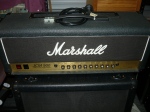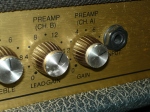 Hello and welcome back to our blog. Today we will draw your attention to the fact that we have been servicing the JCM900 series of Marshall amplifiers, since their debut in the Australian marketplace, back in the 1990’s. In fact we were an authorised Marshall warranty repairer back in those times when Marshall quality control had really slipped very badly. An alarming number of JCM900’s (also Valvestates, etc) were returned for repair under warranty. The good news is once their problems were properly sorted out, they continued to give their owners reliable service.
Hello and welcome back to our blog. Today we will draw your attention to the fact that we have been servicing the JCM900 series of Marshall amplifiers, since their debut in the Australian marketplace, back in the 1990’s. In fact we were an authorised Marshall warranty repairer back in those times when Marshall quality control had really slipped very badly. An alarming number of JCM900’s (also Valvestates, etc) were returned for repair under warranty. The good news is once their problems were properly sorted out, they continued to give their owners reliable service.
 In this blog, we are considering the Model 4100 100 Watt High Gain Dual Reverb (head), probably the most common of the several models of JCM900’s, which were available as 50W or 100W, but the 100W is the one we see most often. There were also “Master Volume’ models, plus a higher gain SL-X, all without the inclusion of reverb. There were problems with the supply of EL34 power output valves when these amps were first introduced, and so the first production amps were shipped with (Sovtek) 5881 output valves, with a sticker on the amp chassis to explain this. Later in the production run, when EL34 valve supplies were restored, Marshall reinstated these. If you have an earlier JCM900, we can restore your amp to EL34 power output with a relatively simple couple of MOD’s.
In this blog, we are considering the Model 4100 100 Watt High Gain Dual Reverb (head), probably the most common of the several models of JCM900’s, which were available as 50W or 100W, but the 100W is the one we see most often. There were also “Master Volume’ models, plus a higher gain SL-X, all without the inclusion of reverb. There were problems with the supply of EL34 power output valves when these amps were first introduced, and so the first production amps were shipped with (Sovtek) 5881 output valves, with a sticker on the amp chassis to explain this. Later in the production run, when EL34 valve supplies were restored, Marshall reinstated these. If you have an earlier JCM900, we can restore your amp to EL34 power output with a relatively simple couple of MOD’s.
 A significant departure in design philosophy from the previous JCM800 series amps, is the inclusion of solid-state preamp circuitry and clipping stages, combined with two 12AX7 valve gain stages and a 12AX7 EQ buffer stage. The reverb circuitry is completely solid-state. The exception to this is the SL-X model which is totally 12AX7 valve preamp circuitry. Therefore, as some of the High Gain Dual Reverb sound is being created in the solid-state preamp circuitry, the selection of preamp valves doesn’t seem to be as critical as in an all-valve high-gain circuit. The 12AX7’s are there to warm things up a bit, but they are not contributing high gain. The ‘normal’ channel employs LED’s as clipping diodes, and the ‘boost’ channel employs silicon diodes. The ‘lead gain’ control in the ‘boost’ channel goes all the way to ’20’, no doubt inspired by the 1980’s movie This is Spinal Tap. The phase-inverter and output stages are conventional Marshall valve circuits, although there are some changes from the earlier and very successful JMP & JCM800 designs.
A significant departure in design philosophy from the previous JCM800 series amps, is the inclusion of solid-state preamp circuitry and clipping stages, combined with two 12AX7 valve gain stages and a 12AX7 EQ buffer stage. The reverb circuitry is completely solid-state. The exception to this is the SL-X model which is totally 12AX7 valve preamp circuitry. Therefore, as some of the High Gain Dual Reverb sound is being created in the solid-state preamp circuitry, the selection of preamp valves doesn’t seem to be as critical as in an all-valve high-gain circuit. The 12AX7’s are there to warm things up a bit, but they are not contributing high gain. The ‘normal’ channel employs LED’s as clipping diodes, and the ‘boost’ channel employs silicon diodes. The ‘lead gain’ control in the ‘boost’ channel goes all the way to ’20’, no doubt inspired by the 1980’s movie This is Spinal Tap. The phase-inverter and output stages are conventional Marshall valve circuits, although there are some changes from the earlier and very successful JMP & JCM800 designs.
What problems do we typically expect to see when a JCM900 is delivered to the workshop ?? Damaged pots & jacks would be high on the list. For whatever reasons, the Alpha split-shaft, PCB mounting pots are often damaged (ie, cutting in & out) to the point of requiring replacement. This is not a huge problem, we always have them in stock, and they are not expensive. The 9-pin (12AX7) valve sockets often are not doing their job, creating intermittent problems. Once again, these are not expensive – they are hand-wired, which is a good thing, but it is a labour intensive job to replace them. And of course, if the amp has had a hard-rocking life, a new pair or quartet of output valves (and power amp rebias) will be required.
Some of the 100 watt units will become unstable with a new set of valves. Some were possibly only marginally stable all along. There have been a couple of very basic valve amp design rules which have been overlooked by the design team, in the JCM900 series. Both the control grids and screen grids of each output valve must be fitted with a ‘stopper’ resistor, mounted as close to the valve socket as possible. When Marshall reinstated EL34 output valves, they installed 4 x 2.2K/5 watt screen grid resistors on the board for the 100 watt models. This is very good design practice but unfortunately, they are not really close to the actual sockets. The big mistake was with the control grid resistors – 1.5K was used in lieu of the traditional Marshall value of 5.6K, and it gets worse – two of them are mounted on the board, and only two at the sockets.
We would automatically install 4 x 5.6K (or higher) control grid resistors directly on the sockets, with all 100 watt JCM900 amps that we receive in the workshop. In the case of particularly unstable amps, we would increase the value of the control grid resistors. The great HIWATT amps of the 1970’s used 22K resistors in this position as standard, for example. These comments re grid ‘stopper’ resistors apply even more so to the original production run of made-in-China VOX AC100 amps, by the way.
What were the most common customer complaints (if any) about the JCM900 series amps, then and now ?? Ref the ‘master volume’ models, the original production run had very limited headroom – there was virtually no ‘clean’ sound at all. This was possibly down to the solid-state clipping circuitry ?? In any case, this issue was solved with the introduction of the SL-X ‘master volume’ model, which was all valve circuitry, except for the FX Loop. In the case of the ‘High Gain Dual Reverb’ models, overwhelmingly the complaint would be that the amps were really incredibly bright, requiring the ‘treble’ and ‘presence’ controls to be set counter-clockwise to compensate. We can assist with this issue, by implementing some simple power amp MOD’s (including: see the above paragraphs), resulting in a smoother top end response, and making the EQ controls useable again. These MOD’s do not reduce in any way the overdrive capability of these amps.
Thanks for checking in to the blog, Ivan Richards.
September 29, 2021 at 1:06 pm |
Thanks Ivan, this was very interesting as I’ve got a 5881 900 , so far it’s been pretty good and I love it’s classic rock sound without being too dirty but still vibrating the Windows and most peoples drinks. !
Hope your keeping well mate
Cheers Sam Figallo
September 29, 2021 at 1:39 pm |
hello Sam – good to hear from you; I still get the occasional JCM900 in for a service; better to work on than the newer Marshalls from JCM2000 onwards; remember the Union Hotel Gosford, where we often played with yourself on front-of-house ?? it’s now a hole in the ground – they are building something very grand on that site (or they were before COVID struck); please stay in touch; IR.